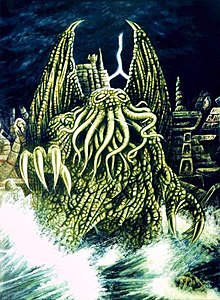Portal:Cthulhu Mythos
The Cthulhu Mythos, also known as the Lovecraft Mythos, is a shared fictional universe created in the 1920s by American horror writer Howard Phillips Lovecraft. The term was coined by Lovecraft's associate August Derleth, and named after Cthulhu, a powerful fictional entity in Lovecraft's stories. It refers to a loose framework formed by common elements (such as places, names, or entities) that appear in more than one tale, adding continuity and depth to the works.

Lovecraft Mythos
[edit]The Lovecraft Mythos is the term coined by the scholar S. T. Joshi to describe the imaginary mythical backdrop, settings, and themes employed by the American weird fiction writer H. P. Lovecraft. Lovecraft's mythos is the foundation of a fictional myth-cycle known as the "Cthulhu Mythos", first recognized and developed by the writer August Derleth, that places a particular group of Lovecraft's stories into a separate and distinct category.
- Dagon, 1919
- Nyarlathotep, 1920 (introduces Nyarlathotep)
- The Statement of Randolph Carter, 1920
- The Crawling Chaos, 1921
- The Nameless City, 1921
- The Picture in the House, 1921
- Herbert West: Reanimator, 1922
- The Hound, 1922 (introduces the Necronomicon)
- The Festival, 1923
- Under the Pyramids, 1924 (Ghostwritten for Harry Houdini)
- The Colour Out of Space, 1927
- The Call of Cthulhu, 1926 (introduces Cthulhu)
- The Dunwich Horror, 1929
- The Whisperer in Darkness, 1931 (first use of the Mi-go by name)
- The Dreams in the Witch-House, 1933 (introduces the Elder Things)
- From Beyond, 1934
- Through the Gates of the Silver Key, 1934, by H. P. Lovecraft and E. Hoffmann Price
- At the Mountains of Madness, 1936
- The Haunter of the Dark, 1936
- The Shadow Out of Time, 1936 (introduces the Great Race of Yith)
- The Shadow Over Innsmouth, 1936 (introduces Deep Ones)
- The Thing on the Doorstep, 1937
- Azathoth, published posthumously in 1938, written in 1922 (introduces Azathoth)
- The Descendant, 1938
- The Case of Charles Dexter Ward, published posthumously in 1941, written in 1927 (introduces Yog-Sothoth)
- The Dream-Quest of Unknown Kadath, published posthumously in 1943, written in 1926-27 (introduces the Elder Sign)
Pre-Lovecraft Mythos
[edit]Lovecraft borrowed terms and ideas from earlier writers he admired: Hastur, for example, was originally a benevolent deity mentioned in an Ambrose Bierce story, but took on more sinister traits when appropriated a few years later by Robert W. Chambers. Lovecraft's only references to Hastur are in "The Whisperer in Darkness".
- Haïta the Shepherd, 1893, by Ambrose Bierce
- The King in Yellow, 1895, by Robert W. Chambers
- The Great God Pan, 1894, by Arthur Machen, was a major influence on the theme of half-human hybrids in "The Dunwich Horror", in which Machen and this story are explicitly referenced.
- "The White People", 1904, also by Machen, is the source of the Aklo language referenced in "The Haunter of the Dark" and "The Dunwich Horror", but mentioned only as "the Aklo letters".
Contemporary Mythos
[edit]During the latter part of Lovecraft's life, there was much borrowing of story elements among the authors of the "Lovecraft Circle", and many others, a clique of writers with whom Lovecraft corresponded. This group included Clark Ashton Smith, Robert E. Howard, Robert Bloch, Frank Belknap Long, and Henry Kuttner. Most of the elements of Lovecraft's Mythos were not a cross-pollination of the various story-cycles of the Lovecraft Circle, but were instead deliberately created by each writer to become part of the Mythos. ... Lovecraft effectively connected Smith's creation to his story-cycle by placing Tsathoggua alongside such entities as Cthulhu, Yig, Shub-Niggurath, and Nug and Yeb in subterranean K'n-yan. Howard frequently corresponded with H. P. Lovecraft, and the two would sometimes insert references or elements of each others' settings in their works. Later editors reworked many of the original Conan stories by Howard; thus, diluting this connection. Nevertheless, many of Howard's unedited Conan stories are arguably part of the Cthulhu Mythos.
- The Thing From—"Outside", 1923 by George Allan England (Not intended as a Mythos story but later included in The Ithaqua Cycle collection of stories)
- The Space-Eaters, 1928 by Frank Belknap Long
- The Hounds of Tindalos, 1929 by Frank Belknap Long
- The Curse of Yig, 1929 by H. P. Lovecraft and Zealia Bishop (introduces Yig)
- The Tale of Satampra Zeiros, 1931 by Clark Ashton Smith (introduces Tsathoggua)
- "The Children of the Night", 1931 by Robert E. Howard (introduces Unaussprechlichen Kulten)
- "The Black Stone", 1931 by Robert E. Howard
- "The Return of the Sorcerer" by . in Strange Tales of Mystery and Terror, 1 (1) (September 1931)
- People of the Dark, 1932 by Robert E. Howard
- Worms of the Earth, 1932 by Robert E. Howard
- The Horror in the Museum, 1933 by H. P. Lovecraft and Hazel Heald
- The Haunter of the Ring, 1934 by Robert E. Howard
- The Shambler from the Stars, 1935 by Robert Bloch
- The Challenge from Beyond, 1935 by Robert E. Howard, Frank Belknap Long, H. P. Lovecraft, A. Merrit and C. L. Moore
- The Secret of Kralitz, 1936 by Henry Kuttner (introduces Iod)
- The Horror in the Burying-Ground, 1937 by H. P. Lovecraft and Hazel Heald
- Dig Me No Grave, 1937 by Robert Ervin Howard
- Medusa's Coil, 1939 by H. P. Lovecraft and Zealia Bishop
Post-Lovecraft Mythos
[edit]The second stage began with August Derleth (The Derleth Mythos), who added to the mythos and developed the elemental system, associating the pantheon with the four elements of air, earth, fire, and water. Derleth combined Lovecraft's various cycles to create a large, singular story-cycle.
- The House in the Valley, 1953, by August Derleth.